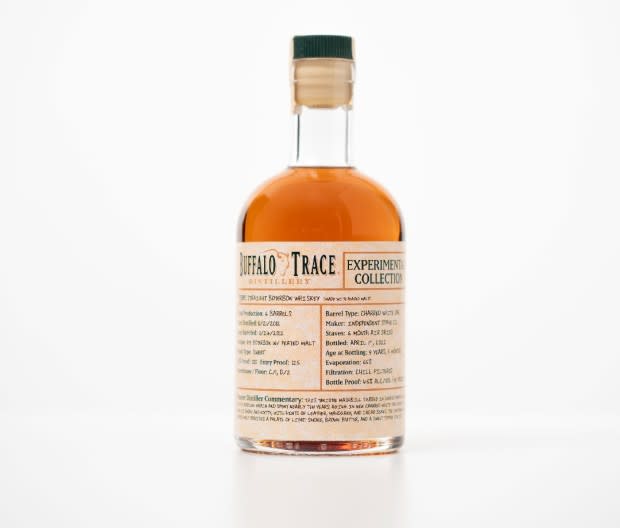Buffalo Trace Releases Ultra-Rare Peated Bourbon, the Latest in Its Experimental Collection
Buffalo Trace bottles some of the most sought-after whiskeys on the planet. The Kentucky-based distillery is responsible for Pappy Van Winkle, George T. Stagg, Eagle Rare, and many other exalted expressions capable of whipping just about any bourbon fan into a frenzy. Nevertheless, no matter how impressive their laurels may be, the craftspeople here hardly seem content to rest on them.
In addition to being one of the most acclaimed distilleries in the industry, it's also among the most creative and experimental—always eager to push limits of flavor. For proof, you needn’t look further than the Buffalo Trace Experimental Collection. Debuting in 2006, the series has now expanded to include its 26th release: Peated Bourbon. What can you expect inside the glass? Let’s uncork this one.

Courtesy image
Buffalo Trace Peated Bourbon Mashbill
The liquid in question began its life nearly a decade ago, when master distiller Harlen Wheatley crafted distillate that included a peated malt in its mashbill. The smoked grain was sourced from the United Kingdom (most likely Scotland) and replaced traditional barley—an ingredient which often accounts for up to 10 percent of the cereals used during fermentation.
Outside of that unorthodox substitution, everything about the process was de rigueur for standard bourbon making. The majority of the mashbill consisted of corn, the secondary grain was rye, and after distillation it entered unused barrels staved with charred American oak.
“The Experimental Collection is not about breaking the rules of bourbon,” Wheatley confirms. “In fact, 95 percent of our experiments stay within the confines of traditional methods of making whiskey.”
Related: The Best American Single Malt Whiskeys of 2023
Notable examples from the past include bourbons that used rice or oats in place of rye in the mashbill—whiskeys that were bombarded with infrared light or aged in barrels that were charred four times longer than usual.
“We conduct this research to better understand the variables that affect our final flavor profiles,” adds Wheatley.

Courtesy image
In the case of the peated offering, the variable introduces an expected smokiness to the nose—though not the sort you’d suss out of, say, an Islay Scotch. For this one you’re picking up a smoldered nut sort of sensation and the faintest tease of Kansas City BBQ. The palate unloads leather and burnt butter before a succinct finish of molasses. Not exactly the tasting notes you’re used to in a bourbon, but we’re not complaining—and nor is Wheatley.
“We anticipated it providing the perfect hint of smoke, just enough to complement the sweet and spicy notes from the rye,” he says of the experiment. “I’m happy to report our hypothesis was correct.”
Related: Midleton Very Rare Reveals $54K Chapter Four Irish Whiskey
It took careful monitoring to deliver such a result. Because the liquid was unlike anything Buffalo Trace had worked with before, Harlen and his team drew from the six barrels frequently as they aged, on the lower levels of the distillery’s two oldest warehouses.
“We did that to minimize the heat effects to aging that we see on upper levels—in effect slowing the aging process,” he explains. “After nine years and five months of aging, we deemed it ready for the chill-filtration process, bottling the final liquid at 90 proof.”

Courtesy image
You can now try buying it at a suggested retail price of $47 per 375 ml bottle. But as with all things Buffalo Trace, it won’t be easy given that only six barrels worth of liquid were laid down. Even when stretched out across the smaller size format, there’s just not that much glass to go around.
It probably won’t be long before this one earns the moniker “Peated Pappy” and starts selling for 20 times that on secondary markets.
The good news is that Buffalo Trace is wholly devoted to funding these flavor forays well into the future. In fact, it currently holds more than 30,000 experimental barrels in its arsenal. A decade ago, it even built a dedicated facility—Warehouse X—to house its research. We’re quite eager to taste whatever will be rolling out of there next. Y’know, in the name of science.


